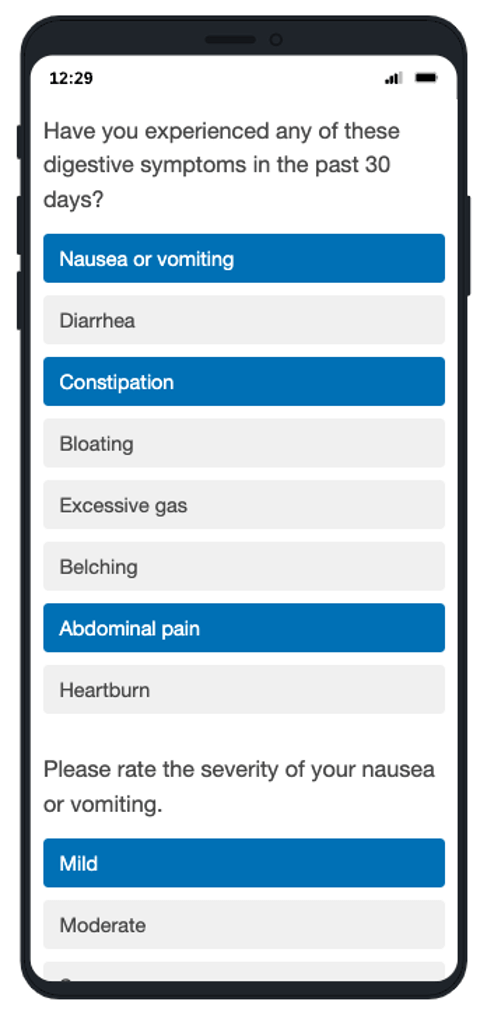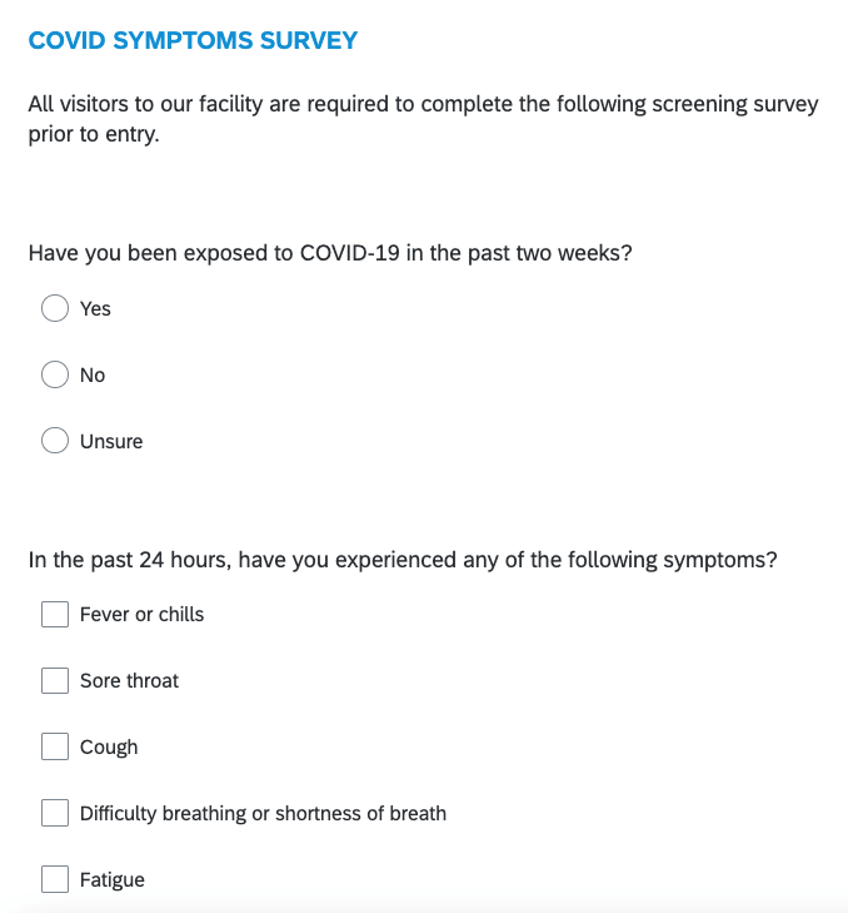What is a symptoms survey?
A symptoms survey is a tool that has long been used by healthcare providers and medical practices. A symptoms survey asks patients questions about symptoms they are currently experiencing, often related to a particular disease or ailment.
What is a symptoms survey used for?
Historically, symptom surveys have been used in healthcare for a few distinct purposes:
- Assessing a patient’s symptoms to give a healthcare provider a better understanding of what the patient is experiencing and to guide discussions about next steps or treatment options
- Gauging the change in a patient’s symptoms over time
- Helping a patient to determine if they should discuss their symptoms with a doctor
A symptoms survey may be recommended or required by a medical provider in order to assess or treat a patient. Some symptom surveys are widely available for individuals who search for their symptoms online, and are used to suggest next steps or provide additional information.

Traditionally, these surveys have been limited to use in healthcare or for healthcare-related research, but due to the coronavirus disease (COVID-19) pandemic, they’ve become increasingly common in areas other than healthcare.
The broad adoption of symptoms surveys to meet the needs of the pandemic unveiled opportunities to use these surveys for many additional purposes.
How are symptoms surveys used for COVID-19?
Since early 2020, the use of symptom surveys has skyrocketed and expanded due to COVID-19. These surveys follow a similar structure to the surveys already in use in healthcare, and have been commonplace since the early months of the pandemic.
COVID-19 symptoms surveys in healthcare
Healthcare systems, providers, and researchers use these surveys to gather information about COVID-19 symptoms for a variety of uses. This typically includes:
- Screening patients with non-COVID medical appointments for presence of COVID-19 symptoms to determine if they may enter a healthcare facility
- Screening healthcare employees for presence of COVID-19 symptoms prior to the start of a shift
- Evaluating patients for likelihood of COVID-19 infection versus other common respiratory illnesses
- Providing testing, isolation, and medical guidance to patients following a close contact exposure or a positive test result
- Exploring possible correlations between COVID-19 infection and other health problems
- Understanding the full impact of COVID-19 on patients’ mental health and quality of life
- Performing contact tracing for patients with positive test results and following/predicting the spread of the coronavirus disease and each of its variants
COVID-19 symptoms surveys outside of healthcare
What is unique about COVID-19 symptoms surveys is their prevalence outside of the healthcare industry.
These surveys were widely used in the first half of the pandemic, and in many cases still are used as screening tools to grant entry to certain facilities, events, and gatherings.
Furthermore, following guidance from the Centres for Disease Control and Prevention (CDC), colleges and universities throughout the country required students and staff to complete a daily symptom survey before they were granted access to campus. Many other entities, particularly health systems and government agencies, had similar requirements.

What is the CDC’s stance on symptoms surveys?
The CDC does not hold an official position on the use of symptoms surveys on a broad level, nor does it offer symptom surveys for most diseases, including common illnesses such as the flu. The only symptoms surveys offered by the CDC are specific to the COVID-19 pandemic:
- The COVID-19 symptom checker is available for the general population to assess risk or likelihood of COVID-19 infection based on the latest information about the disease, or to determine if symptoms are severe enough for medical attention
- The standard facility access symptom survey can be used as-is or adapted by facilities to screen visitors prior to entry
Throughout the pandemic, the CDC has recommended daily symptom screening in certain settings, such as healthcare facilities, institutions of higher learning, and prisons. Virtual screening and electronic symptom monitoring systems have also been among the CDC’s recommended screening tools.
How has COVID-19 changed the way symptoms surveys are used?
The prevention of COVID-19 outbreaks has required rapid development of new tools. Adapting traditional symptom surveys helped us to quickly meet the unique and unprecedented needs of the pandemic — not only within healthcare, but across a wide range of settings within our communities.
The use of symptom surveys in response to COVID-19 has shown how dynamic and adaptable these types of surveys can be. There is likely a great deal of untapped potential in symptom surveys as a whole.
How do you utilise a symptoms survey?
If you’re thinking about using a symptoms survey in your organisation, plan ahead to get the most out of it. Here are a few tips:
Take advantage of technology
Using an experience management platform will allow you to do more with your symptoms survey. When you design and distribute your survey with this technology, you can track responses, uncover trends, incorporate custom workflows, and connect directly with your respondents.
Identify your goals
What are you trying to achieve with your symptoms survey? Before you create and distribute it, clearly define its purpose and your audience.
- Will this survey apply to all patients or only to certain subsets of patients?
- Who will need access to the results?
- What will trigger the need for a patient to complete the survey?
Craft the right questions
The information collected on a symptoms survey can vary from one survey to the next, depending on its specific purpose. For example, you could ask patients to:
- Select checkboxes for each symptom they are experiencing
- Rate the severity of their symptoms on a numeric scale
- Indicate the frequency of their symptoms
- Specify when their symptoms first began
- Indicate a correlation of their symptoms to certain activities
- Include free-text comments to provide additional context about their symptoms
Reach patients through the right channels
In the past, symptom surveys were often done on paper. Today, most patients are likely to access these surveys on their computers or mobile devices. The method you choose to distribute your symptoms survey will depend on your intended goals.
For example, a survey for members of the general public to determine if they should talk to a doctor about their symptoms may be accessible on your website’s homepage.
Alternatively, you may choose to email the survey directly to a patient who’s registered with your practice if you need to gauge the extent of their symptoms.
The methods of symptoms survey distribution, specifically for COVID-19, may vary. Many entities using a symptoms survey as a COVID-19 screening tool require respondents to log into a secure portal to access the survey — such as students or employees.
What do you do with the results of a symptoms survey?
Just as COVID-19 reimagined the reasons for which a symptom survey can be used, it also shed new light on what we can do with the results from these types of surveys. The convergence of technology and COVID-19 symptoms surveys led to the discovery of new opportunities for driving action with responses.
What you can do with symptoms survey results depends on the purpose of the survey, as well as its design and the types of questions included. When you offer symptom surveys digitally using a platform with built-in analytics and workflow options, there are many ways you can use the results. For example, symptom survey results can be beneficial to your organisation on a broader level, or they can be used to directly assist patients with discussions about their healthcare and with access to care.
Here are a few ways to make the most of your insights…
Dashboards and visualisations
Expand the possibilities of your symptoms survey with dashboards and visualisations. Look for trends, patterns, and correlations in the survey responses that may help you to better understand patient experiences with certain conditions and symptoms.
Connect with patients
With the right technology, you can use workflows to take immediate action when a patient completes a symptoms survey.
Imagine a patient completes a symptoms survey assessing their risk for diabetes. If the patient’s responses indicate a high risk for the disease, you may want to help them to book an appointment with your clinic right then and there.
Alternatively, a patient may complete a symptoms survey to assess the likelihood they have contracted the coronavirus disease. In this case, based on the patient’s responses you may send them directly to a link to schedule a test upon completion of the survey.
Design your symptoms survey with Qualtrics
With Qualtrics XM Guided Solutions, you can design a symptoms survey to fit any need. From traditional symptom questionnaires to COVID-19 screenings for patients and employees and beyond, Qualtrics has the tools to optimise your symptoms survey opportunities.
But there’s more with Patient Experience solutions, you can elevate the quality of care you deliver to patients and your people through a 360-degree view of their journey. This allows you to take the right actions at the right time to deliver the most effective treatments and ensure the best outcomes.
Create the optimal patient experience with Qualtrics